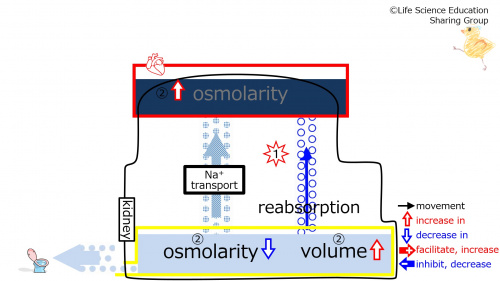「SHolroydAtWeilCornellMedQatar/Urology/Kidney/Tubules/WaterReabsorption/EffectOfDecrease」の版間の差分
編集の要約なし |
編集の要約なし |
||
| 1行目: | 1行目: | ||
{{Point| | {{Point| With a decrease in the water reabsorption from the tubule, plasma osmolarity and urine volume increase, and urine osmolarity decreases.尿細管からの水分再吸収が減少すると、血漿浸透圧は上昇し、尿量は増加し、尿浸透圧は低下する。}} | ||
[[メディア:6-ADHcontrol-sweat.mp4|narrated video explanation]] | [[メディア:6-ADHcontrol-sweat.mp4|narrated video explanation]] | ||
| 8行目: | 8行目: | ||
[[メディア:WaterReabsorptionBaseLine-Eng.mp4|video prior to the decrease in vasopressin (ADH)]]<br> | [[メディア:WaterReabsorptionBaseLine-Eng.mp4|video prior to the decrease in vasopressin (ADH)]]<br> | ||
--> | --> | ||
Prior to | Prior to the water reabsorption from the tubule decreasing (at baseline), we will make the assumption that the subject is in homeostasis with normal plasma and urine osmolarities (isotonic) and urine volume.尿細管からの水分再吸収の減少前(ベースライン)では恒常性が保たれていて、血漿浸透圧と尿浸透圧は正常(等張)、尿量も正常であるとしましょう。 | ||
<br style="clear:both;" /> | <br style="clear:both;" /> | ||
</div> | </div> | ||
| 17行目: | 17行目: | ||
[[メディア:WaterReabsorptionEffectOfDecrease-2Eng.mp4|video just after the decrease in vasopressin (ADH)]]<br> | [[メディア:WaterReabsorptionEffectOfDecrease-2Eng.mp4|video just after the decrease in vasopressin (ADH)]]<br> | ||
--> | --> | ||
Step 1: Suppose that the | Step 1: Suppose that the reabsorption of water from the tubule decreases.図の①:最初に、尿細管からの水分再吸収が減少したとします。 | ||
<br style="clear:both;" /> | <br style="clear:both;" /> | ||
| 26行目: | 25行目: | ||
[[メディア:WaterReabsorptionEffectOfDecrease-3Eng.mp4|video showing the changes in plasma and urine after the decrease in vasopressin (ADH)]]<br> | [[メディア:WaterReabsorptionEffectOfDecrease-3Eng.mp4|video showing the changes in plasma and urine after the decrease in vasopressin (ADH)]]<br> | ||
--> | --> | ||
Step | Step 2: With the decrease in water reabsorption, concentrated (hypertonic) solution enters the plasma. This increases plasma osmolarity (concentrated, hypertonic). Because concentrated (hypertonic) solution leaves the tubule due to reabsorption, the fluid remaining in the tubule has an decreased osmolarity (diluted, hypotonic). Also, with the decrease in water reabsorption, there is more water remaining in the tubule. Overall, the urine becomes diluted and increases in volume.図の②:水分再吸収が減少し、濃い溶液(高張液)が血漿に入ります。これにより血漿浸透圧が上昇し(濃く、高張になり)ます。 | ||
再吸収で濃い溶液(高張液)が尿細管から出るため、残る液の浸透圧が低下し(薄く、低張になり)ます。水分再吸収も減少するため、尿細管に残る水分は増加します。つまり尿は薄く、多量になります。 | |||
<br style="clear:both;" /> | <br style="clear:both;" /> | ||
</div> | </div> | ||
| 36行目: | 36行目: | ||
//LEVEL:3 | //LEVEL:3 | ||
//RAND | //RAND | ||
With a decrease in the | With a decrease in the water reabsorption from the tubule, urine volume {~=increases~decreases} .尿細管からの水分再吸収が減少すると、尿量は{=増加~減少}する。 | ||
//LEVEL:2 | //LEVEL:2 | ||
//RAND | //RAND | ||
With a decrease in the | With a decrease in the water reabsorption from the tubule, urine osmolarity {~increases~=decreases} .尿細管からの水分再吸収が減少すると、尿の浸透圧は{~上昇~=低下}する。 | ||
//LEVEL: | //LEVEL:2 | ||
//RAND | //RAND | ||
With a decrease in the water reabsorption from the tubule, plasma osmolarity {~=increases~decreases} . 尿細管からの水分再吸収が減少すると、血漿浸透圧は{=上昇~低下}する。 | |||
</GIFT> | </GIFT> | ||
2020年3月15日 (日) 17:31時点における版
| With a decrease in the water reabsorption from the tubule, plasma osmolarity and urine volume increase, and urine osmolarity decreases.尿細管からの水分再吸収が減少すると、血漿浸透圧は上昇し、尿量は増加し、尿浸透圧は低下する。 |
Prior to the water reabsorption from the tubule decreasing (at baseline), we will make the assumption that the subject is in homeostasis with normal plasma and urine osmolarities (isotonic) and urine volume.尿細管からの水分再吸収の減少前(ベースライン)では恒常性が保たれていて、血漿浸透圧と尿浸透圧は正常(等張)、尿量も正常であるとしましょう。
Step 1: Suppose that the reabsorption of water from the tubule decreases.図の①:最初に、尿細管からの水分再吸収が減少したとします。
Step 2: With the decrease in water reabsorption, concentrated (hypertonic) solution enters the plasma. This increases plasma osmolarity (concentrated, hypertonic). Because concentrated (hypertonic) solution leaves the tubule due to reabsorption, the fluid remaining in the tubule has an decreased osmolarity (diluted, hypotonic). Also, with the decrease in water reabsorption, there is more water remaining in the tubule. Overall, the urine becomes diluted and increases in volume.図の②:水分再吸収が減少し、濃い溶液(高張液)が血漿に入ります。これにより血漿浸透圧が上昇し(濃く、高張になり)ます。
再吸収で濃い溶液(高張液)が尿細管から出るため、残る液の浸透圧が低下し(薄く、低張になり)ます。水分再吸収も減少するため、尿細管に残る水分は増加します。つまり尿は薄く、多量になります。
Challenge Quiz
With a decrease in the water reabsorption from the tubule, urine volume increases decreases .尿細管からの水分再吸収が減少すると、尿量は 増加 減少 する。
With a decrease in the water reabsorption from the tubule, urine osmolarity increases decreases .尿細管からの水分再吸収が減少すると、尿の浸透圧は 上昇 低下 する。
With a decrease in the water reabsorption from the tubule, plasma osmolarity increases decreases . 尿細管からの水分再吸収が減少すると、血漿浸透圧は 上昇 低下 する。



